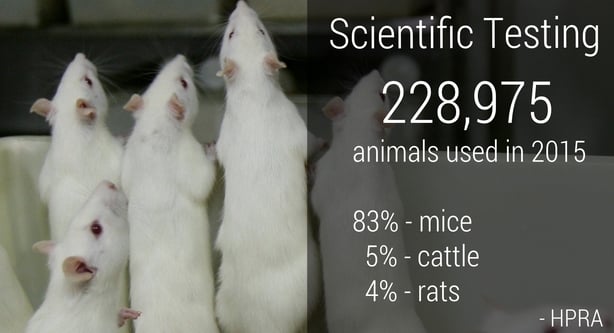The number of animals used in scientific research and testing in this country rose slightly last year, new figures show.
The vast majority were animals that were being used for the first time, with just 1 per cent reused following earlier tests.
In total, 228,975 animals underwent testing here in 2015, up 1 per cent on the previous year, according to the annual statistics released by the Health Products Regulatory Authority.
Of the animals which had not been tested previously, 15,746 or 7% were genetically altered.
However, nearly all of those did not have a harmful phenotype used, which meant there was no impairment to their well-being from the genetic changes.
157,872 of the total number of animals used were for testing the safety, quality and potency of medicines - a necessary requirement under EU law for new drugs.
The next most common use was for basic research (42,347) and translational and applied research (22,984).
As in previous years, mice made up the majority of animals used in tests here, accounting for 83 per cent of the total in 2015.
Cattle made up 5 per cent of the overall amount, followed by rats (4%), "other fish" (2%) and pigs and rabbits (1 per cent each).
All other categories of fish, birds and animals were each under 1% of the total amount.
The percentage of cattle used rose more than three-fold in 2015, with the number of pigs tested growing by over 400 per cent.
Almost all the animals (92%) used were born in the EU at a premises of a registered breeder.
2% of the total animals used in the testing were euthanised at the end of the procedure, which was carried out under general anaesthetic.
Over a quarter of the total were classified as having had a severe response to the testing, a reduction of around a third on the proportion with the same level of response in 2014.
Animals in this category cannot be used again.

When it comes to what was being tested, the report shows that 44% of those used in translational and applied research were used for the purpose of testing around animal diseases and disorders.
18% were used for testing around human nervous and mental disorders, 8% for human musculoskeletal disorders and 6% for human infectious disorders.
The figures have been collated by the HPRA since 2013, when an EU Directive which aims to protect animals used for scientific purposes came into existence.
According to the HPRA, the legislation is among the most advanced pieces of law concerning animal welfare in the world, with the restrictions and standards set by it expected to enhance animal welfare and ensure animals are only used when their use is strongly justified and following independent assessment.
The directive is governed by three principles of replacing animals with alternative forms of testing where possible, reducing the overall numbers used and refinement of the methods used to make them as humane as possible.
According to the HPRA, while the complete replacement of animal studies is the ultimate goal of the directive, it is currently not possible as non-animal research methods are often not suitable for probing certain biological processes.
The HPRA is responsible for regulating the breeders and suppliers of the animals, places where procedures are performed, projects that use animals and for the training of those carrying out the procedures.
29 inspections were carried out last year in establishments where the animals are bred or used for testing, the HPRA says, and it was satisfied with the overall level of care and welfare being provided to the animals, it said.

